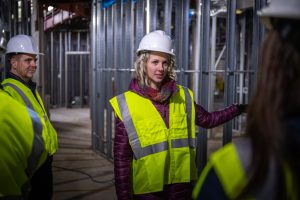On June 10, 2021, President Craft announced at a press conference Concordia would be expanding it’s health professions with a newly renovated building. Concordia is currently refurbishing the Sanford Clinic on Eighth Street for student learning purposes with an estimated time of completion set for Fall 2023.
The construction has been making headway and the building is now fully studded and the rooms have been completely outlined. Director of facilities management Dallas Fossum said, “You can start to feel the space.”
There have only been minor setbacks for the construction and Fossum predicts the construction will be “substantially complete” by June 1, 2023. By this time, all of the major structures will have been completed, leaving only interior finishes, moving in furniture and setting up technology left.
On Oct 14, 2022, the head faculty of the Sanford Heimarck School of Health Professions toured the building to see the construction plans materialize from paper to real life.
Gwen Halaas, Shelly Gompf, Meredith Wagner, Emily Huber-Johnson, Stephen Stapleton and Kelli Gast have been working in conjunction with Fossum to create a learning environment that will cater to interprofessional learning and high-fidelity simulations.

The new simulation labs are modeled after real-world settings, including life-like mannequins and state-of-the-art technology. There will be a total of five simulation labs that portray a board room, telehealth room, a hospital room, a clinical examination room, a psychotherapy room and an in-home assessment room.
“The idea of high fidelity simulation is to make sure that you are providing a scenario that is as close to reality as possible and this will allow us to do that,” said Stapleton.
Each of the simulation labs have a debriefing and control room attached that are separated with two-way glass, allowing professors to guide students without interrupting their learning. Additionally, the rooms will have recording functionality, making it easier for students to review their progress and revisit situations later.
The simulation labs will be equipped with realistic mannequins, which through the process of moulage, can mimic almost any physical injury, including bruises, broken bones and other trauma injuries. The mannequins will also be able to make breathing sounds and can talk via pre-recorded clips.
“The mannequins can do everything but drive a car,” Stapleton said.
In addition to the high-fidelity mannequins and simulation labs, the exercise science and dietetics departments will have an expanded athletic performance lab. Moreover, the department is investing in a bod pod, which is a computerized device that measures the body composition of anyone who sits inside.

Stapleton said students who learn in simulation labs have a better transition into the workforce. Clinicals, although an important part of nursing education, can be overwhelming for students because it is an uncontrolled environment with risks. Students may be pushed to the background in light of a dangerous situation.
“You don’t learn all the intricacies of that situation, whereas in a simulation lab, you can do that,” said Stapleton. “In a controlled environment, you can stop the simulation and talk about what is happening, why and what the next steps are, so when it happens in real life, it’s all memory.”
In addition to lab experience, this building will create interdisciplinary opportunities, which can help bring the health professions at Concordia together. One example of this is a nursing student and social work student completing a simulated in-home assessment together.
“This space is made for interprofessional learning. Here is where we will learn together and think critically about the relationship between professional roles,” Halaas said.
Moreover, the Heimarck Center will also improve faculty opportunities. Concordia hopes to hire a simulation coordinator and expand continuing education opportunities through the Center. The labs are designed to be used for both student classroom settings and for research, which has the potential to benefit Concordia as a whole.
Beyond Concordia, the Heimarck Center may improve the F-M area. Local colleges partnering with Sanford allows for recently graduated students to enter the workforce quickly. Bryan Nermoe ‘95, president and CEO of Sanford Fargo recognizes the potential this college town has to offer to the healthcare community.

“With a record demand for healthcare services, we are at a significant crossroad in our ability to meet workforce challenges. This is why Sanford has historically invested in Concordia College and will continue to do so in the future,” said Nermoe at the press conference held June 10.
This renovation project commemorates the recommitment of Sanford to Concordia for the next 10 years. It will also show appreciation for their support in the past, such as their help with the opening of the Integrated Science Center in 2017. In addition to Sanford’s gift, alumni donations, pledges and naming rights also aided in funding this project.
In thanks for their continuing support, Concordia’s nursing, nutrition, exercise science, social work and healthcare administration programs will now belong to the Sanford Heimarck School of Health Professions. The name will not only recognize Sanford, but also the impact of Theodore Heimarck, a professor who established the healthcare administration program in 1966.
This article has been updated since its original publication on Sept 9, 2021.


